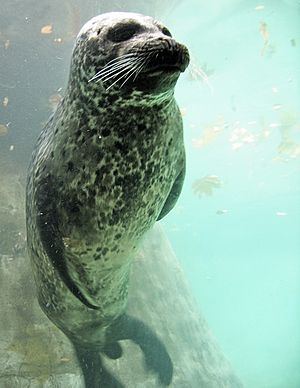Earless seal facts for kids
Quick facts for kids Earless seal |
|
|---|---|
 |
|
| A Common Seal (Phoca vitulina) | |
| Scientific classification | |
| Kingdom: | |
| Phylum: | |
| Class: | |
| Order: | |
| Suborder: | |
| Superfamily: | |
| Family: |
Phocidae
Gray, 1821
|
Earless seals, also known as true seals, are a special group of mammals that live in the ocean. They are part of a larger group called pinnipeds, which also includes fur seals and sea lions. True seals belong to the family Phocidae. People sometimes call them "crawling seals" because of how they move on land, which is different from how sea lions walk.
These amazing animals live in oceans all over the world, from very cold polar areas to warmer temperate regions. The only exception is the Baikal seal, which is the only type of seal that lives only in freshwater.
Contents
How Earless Seals Evolved
The oldest known fossil of an earless seal is called Noriphoca gaudini. It was found in Italy and lived about 23 to 28 million years ago. Other early true seals appeared about 15 million years ago in the North Atlantic Ocean.
For a long time, scientists thought that true seals evolved separately from other pinnipeds like sea lions and walruses. They believed seals might have come from otter-like animals. However, newer evidence suggests that all pinnipeds, including true seals, sea lions, and walruses, actually came from a single ancestor. This ancestor might have been similar to an animal called Enaliarctos, and it was likely related to animals like weasels and bears.
Scientists now think that monk seals, elephant seals, and the seals that live in Antarctica all developed in the southern parts of the world. From there, they spread out to the different places where they live today.
Types of Earless Seals
There are many different kinds of earless seals in the family Phocidae. They are divided into two main groups, called subfamilies:
Monk Seals and Elephant Seals (Subfamily Monachinae)
This group includes some very interesting seals:
- Monk Seals: These seals live in warmer waters. Sadly, the Caribbean Monk Seal is now extinct (meaning it no longer exists). We still have the Mediterranean Monk Seal and the Hawaiian Monk Seal, but they are very rare.
- Elephant Seals: These are the largest seals! They get their name from the male's huge nose, which looks a bit like an elephant's trunk. There are two types: the Northern Elephant Seal and the Southern Elephant Seal.
- Antarctic Seals: These seals live in the very cold waters around Antarctica. They include the Ross Seal, Crabeater Seal, Leopard Seal, and Weddell Seal. The Crabeater Seal is one of the most common large mammals on Earth!
Northern Seals (Subfamily Phocinae)
This group mostly lives in the colder waters of the Northern Hemisphere:
- Hooded Seal: This seal has a special inflatable "hood" on its head.
- Bearded Seal: Known for its long, sensitive whiskers that look like a beard.
- Ribbon Seal: This seal has beautiful light-colored bands or "ribbons" on its dark fur.
- Common Seal or Harbor Seal: These are often seen near coastlines and in harbors.
- Harp Seal: Famous for its striking dark markings on its back, which look like a harp as they grow older.
- Ringed Seal: These seals are smaller and have distinctive ring-shaped patterns on their fur. The Saimaa ringed seal is a very endangered type that lives only in a lake in Finland.
- Caspian Seal: This seal lives in the Caspian Sea.
- Baikal Seal: The only seal that lives entirely in freshwater, found in Lake Baikal in Siberia.
- Grey Seal: A large seal with a distinctive "horse-like" snout.
Images for kids
-
A Harbor seal skull (Phoca vitulina)
-
Living only in Lake Saimaa, Finland, Saimaa ringed seals, a subspecies of ringed seal, are among the most endangered seals in the world, having a total population of only about 400 individuals.
See also
 In Spanish: Foca para niños
In Spanish: Foca para niños








